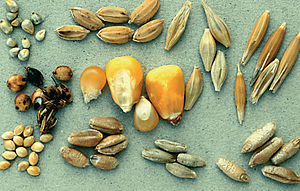
Back Graan Afrikaans Getreide ALS እህል Amharic Cerial AN Corn ANG محصول حبوب Arabic حبوب ARZ Cereal AST Dənli bitkilər Azerbaijani Иген культуралары Bashkir


(middle) sorghum, maize, oats
(bottom) millet, wheat, rye, triticale
A cereal is a grass cultivated for its edible grain. Cereals are the world's largest crops, and are therefore staple foods. They include rice, wheat, rye, oats, barley, millet, and maize. Edible grains from other plant families, such as buckwheat and quinoa, are pseudocereals. Most cereals are annuals, producing one crop from each planting, though rice is sometimes grown as a perennial. Winter varieties are hardy enough to be planted in the autumn, becoming dormant in the winter, and harvested in spring or early summer; spring varieties are planted in spring and harvested in late summer. The term cereal is derived from the name of the Roman goddess of grain crops and fertility, Ceres.
Cereals were domesticated in the Neolithic, some 8,000 years ago. Wheat and barley were domesticated in the Fertile Crescent; rice was domesticated in East Asia, and sorghum and millet were domesticated in West Africa. Maize was domesticated by Indigenous peoples of the Americas in southern Mexico about 9,000 years ago. In the 20th century, cereal productivity was greatly increased by the Green Revolution. This increase in production has accompanied a growing international trade, with some countries producing large portions of the cereal supply for other countries.
Cereals provide food eaten directly as whole grains, usually cooked, or they are ground to flour and made into bread, porridge, and other products. Cereals have a high starch content, enabling them to be fermented into alcoholic drinks such as beer. Cereal farming has a substantial environmental impact, and is often produced in high-intensity monocultures. The environmental harms can be mitigated by sustainable practices which reduce the impact on soil and improve biodiversity, such as no-till farming and intercropping.